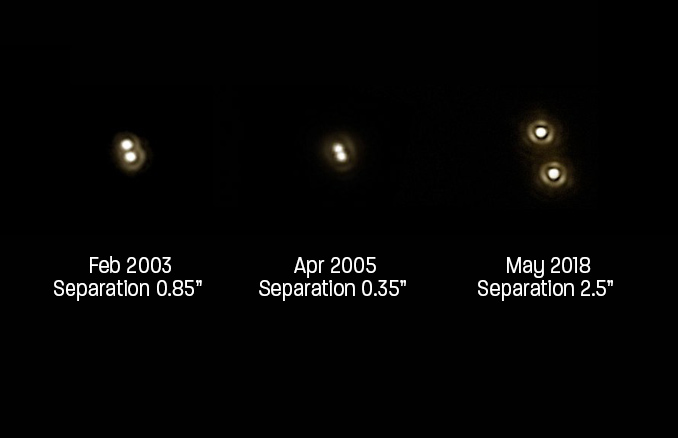Observe the Moon occulting Porrima, Virgo’s celebrated second star. – Astronomy Now

On the morning of 13 May (12/13), the Moon occults Porrima (gamma Virginis), Virgo’s celebrated binary star, in an event that’s visible across the UK. It’s not that common for a star as bright as Porrima (magnitude +2.7) to be occulted, though many first-magnitude stars that lie close to the ecliptic (the apparent path of the Sun across the sky), such as Regulus in Leo and Aldebaran in Taurus, are in the Moon’s firing line. What makes this event worth getting up for, or staying up late to see, is Porrima’s brightness, together with its star status as perhaps the most famous double star in the entire sky.
Moon low in the west
A 12.2-day-old Moon shows a waxing gibbous phase on 12/13 May. In the small hours it’s seen hanging low over the south-western horizon, so to get a good view of Porrima’s occultation make sure you’ve got a suitable observing spot staked out well in advance.
Porrima is the second-brightest star in the large spring constellation of Virgo, an area celebrated for part-hosting (together with Coma Berenices) the Virgo Cluster, the best collection of galaxies in the entire night sky. Porrima is easy to pick out owing to its position at the base of Virgo’s familiar ‘Y’ shaped asterism, an arrangement of seven, third- to fourth-magnitude stars which has become known as ‘the Bowl of Virgo’.

Get ready from midnight BST
By midnight BST, Porrima lies just under a degree east of the moon’s dark limb, the gap closing to about one Moon diameter by 12.45am BST. An hour later from Edinburgh, Porrima is engulfed at the dark limb, followed at 1.56am BST by the occultation from London. The Moon lies 20 degrees high when Porrima temporarily disappears from view.
A small telescope will easily show Porrima split into its virtually identical magnitude +3.6 and +3.7 components. They are currently separated by around 3” and seen in a north-to-south orientation. Both stars will appear to wink out at the same time. A pair of binoculars will give a great view too, though Porrima is seen as a single star.
Porrima reappears at the bright limb at 2.46am and 2.36am BST from London and Edinburgh, respectively, by which time the Moon has descended to an altitude of around 13 to 14 degrees above the west-southwestern horizon.
Porrima: a storied binary star
Porrima is well worth making the effort to observe. This great pairing, found by James Bradley in 1718, is a true binary. It’s formed of nearly identical class F0 main-sequence dwarf stars, Porrima A and B (magnitudes +3.48 and +3.53), that orbit each other in a highly eccentric 169-year-orbit. At their distance of 38 light years, they swing between around 81 and 5 astronomical units (AU; one AU is 149,597,870.700 kilometres), with an average separation of 43 AU.
Porrima’s component stars are easy to separate through a small telescope for the vast majority of the orbit. The last time the stars were at their closest (periastron) occurred in 2005, when between 2002 and 2007 they lay within an arcsecond of each other. Their minimum separation was calculated to be around 0.37 arcseconds; Astronomy Now double star expert Bob Argyle reported “From Cambridge, the eight-inch (200mm) Cooke refractor would only show a barely elongated image, even at 600x”.
The pair have been slowly opening since 2005’s periastron passage and are currently close about 3” apart at a position angle of 180 degrees (north–south).

Read More: Observe the Moon occulting Porrima, Virgo’s celebrated second star. – Astronomy Now

